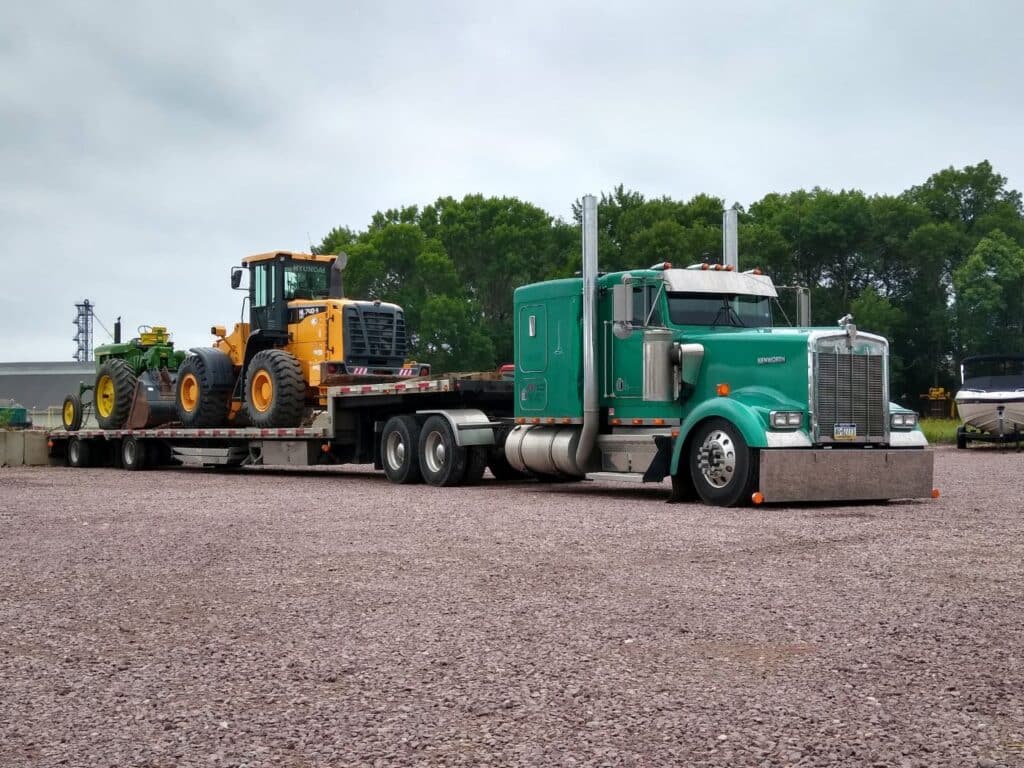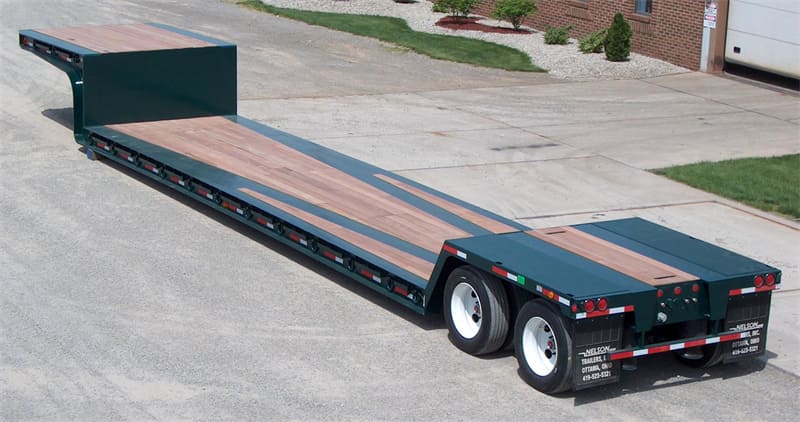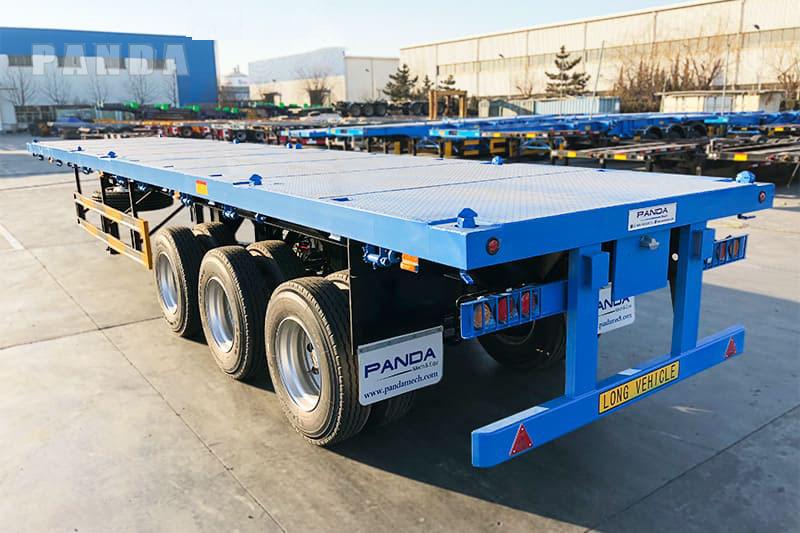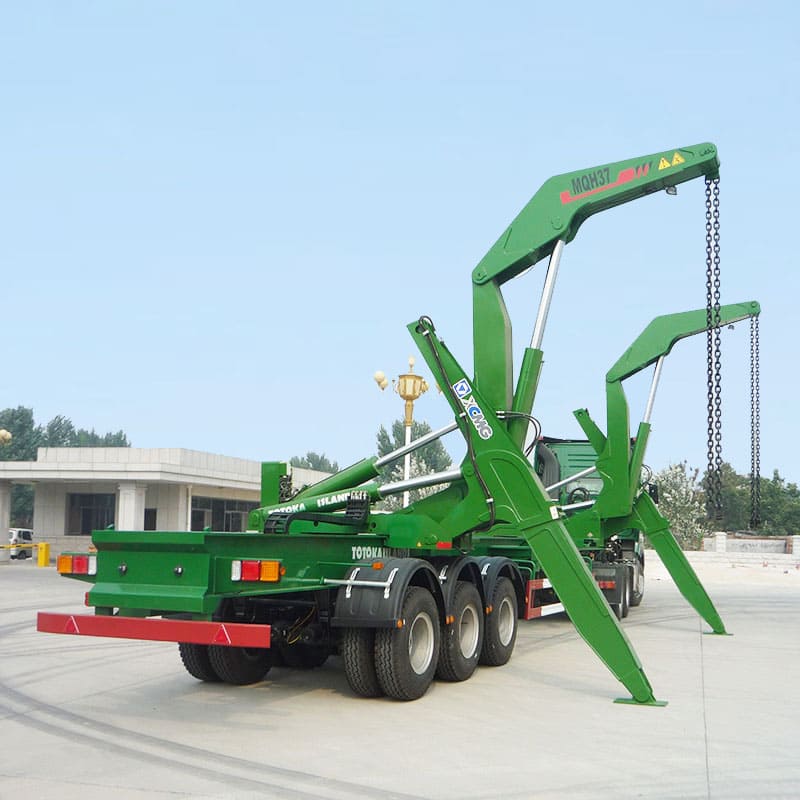Hello, I’m Zac. Many friends have been asking about the types of flatbed trailers. Today we will explain them in detail.
The most common types of flatbed trailers include:
- Standard flatbed: Great for general freight 🚚
- Step deck: Handles taller loads without height permits
- Double drop: Ideal for extra-tall equipment
- Lowboy: Perfect for heavy construction gear
What is a Flatbed Trailer?

The flatbed trailer is a type of trailer with a flat, open deck and no sides or roof. I like how this design makes loading and unloading easy from any direction. When I use flatbed trailers, I can haul all kinds of cargo, even if it’s big, wide, or oddly shaped.
Applications
Flatbed trailers are perfect for hauling cargo that won’t fit in a regular box trailer. I use them most when I need to move big, heavy, or awkward items. Here’s where I see flatbed trailers working best:
- 🏗️ Construction: Moving steel beams, lumber, pipes, and heavy equipment
- 🚜 Agriculture: Hauling tractors, hay bales, and harvested crops
- 🚛 Freight transportation: Carrying machinery, building materials, and large pallets
- 🌎 Logistics: Shipping oversized goods across long distances
- 🏭 Manufacturing: Delivering large parts or finished products
Flatbed trailers play a huge role in industries like construction, agriculture, and freight transportation. I see them everywhere, from city highways to rural roads, because they handle jobs that other trailers just can’t manage.
Different Types of Flatbed Trailers
Standard Flatbed

The standard flatbed is the most popular and versatile type of flatbed trailer. I use this trailer for almost everything. It has a flat, open deck with no sides or roof, which makes loading and unloading super easy. I can haul steel beams, lumber, machinery, and even prefabricated buildings with it.
Here’s why I like the standard flatbed trailer:
- 🚚 Fast loading and unloading from any side with forklifts or cranes
- 🏗️ Carries a wide range of cargo, including oversized and irregular loads
- 💪 Durable construction supports heavy weights and reduces maintenance costs
I often choose a standard flatbed when I want to save time and money. The open design lets me consolidate shipments and handle loads that would need multiple trips with other trailers. Many companies, like Panda Mech, focus on quality and durability, so I know these semi-trailer flatbeds will last a long time.
Tip: If you need a trailer for general freight, the standard flatbed is usually the best choice.
Step Deck (Drop Deck)

Step deck trailers, also called drop decks, are perfect for hauling taller cargo that won’t fit on a standard flatbed. I use step deck trailers when I need to move equipment or materials that are just a bit too tall for regular semi-trailer flatbeds. The deck drops down after the front section, giving me extra height clearance.
I find step deck trailers especially useful in construction and manufacturing. They let me move taller items without needing special permits, which saves time and money. These trailers also offer great stability for mid-level cargos, like lighter earth-moving machines or factory equipment.
Double Drop

Double drop trailers are the go-to choice for hauling extra-tall or oversized equipment. I use double drop trailers when I need to move something massive, like industrial machinery or large tanks. The deck has two drops—one behind the tractor and one before the rear wheels—creating a very low middle section called the “well.”
Here’s what makes double drop trailers stand out:
- 🏗️ Lowest deck height among semi-trailer flatbeds, perfect for tall cargo
- 🚜 Ideal for heavy equipment like bulldozers, cranes, or transformers
- 🛣️ No oversize permits needed for many tall loads
Lowboy

Lowboy trailers are my top pick when I need to haul the heaviest and tallest equipment. These semi-trailer flatbeds have a super-low deck, which lets me move big machines without breaking height rules on the road. I use lowboy trailers for things like bulldozers, cranes, and wind turbine parts.
Here’s what makes lowboy trailers stand out:
- 🏗️ Ultra-low deck height lets me carry loads up to 11 feet 6 inches tall.
- 🚜 Handles massive weight—I can move loads from 25 tons to over 100 tons.
- 🔄 Multiple axles give better weight distribution and stability.
- ⏱️ Removable gooseneck trailer options make loading and unloading much faster.
I always match the number of axles to my cargo. More axles mean I can carry heavier stuff and keep everything safe. When I use a lowboy, I notice better fuel efficiency and fewer problems with road rules. The low deck keeps my load stable, even on bumpy roads.
Here’s a quick table that helps me choose the right lowboy for the job:
| Capacity (tons) | Best For | Axles | Why I Use It |
|---|---|---|---|
| 25-50 | Small construction, farming | 2 | Good for moderate loads, easy to maneuver |
| 51-100 | Big construction, mining | 3 | Handles heavy, oversized equipment |
| 100+ | Oil, wind energy, military | 4 or more | Needed for the heaviest, most oversized loads |
Tip: I always check the deck height and axle count before I pick a lowboy. The right setup saves me time and money.
Removable Gooseneck (RGN)

Removable gooseneck trailers make loading and unloading heavy equipment a breeze. I love using RGNs because I can detach the front of the trailer, drop the deck to the ground, and drive equipment right on. This design saves me a lot of time, especially with big machines that can’t be lifted easily.
Here’s why I choose RGNs for tough jobs:
- 🚜 Easy drive-on loading—no need for ramps or cranes.
- ⏳ Faster loading times—I save up to 30% compared to fixed-neck trailers.
- 🦺 Safer for workers—fewer accidents during loading.
- 🏗️ Great for extra-tall or heavy loads—the low deck handles big machines.
When I move things like excavators or large generators, I always reach for an RGN. The flexibility and safety features make my job easier and keep my cargo secure. I also like that RGNs come in different sizes, so I can match the trailer to my load.
Note: RGNs are a type of lowboy, but with a removable front. This makes them one of the most flexible semi-trailer flatbeds I use.
Extendable (Stretch) Flatbed Trailer

Extendable (stretch) flatbed trailers are my top choice when I need to haul cargo that’s just too long for a regular trailer. These trailers can stretch out to carry things like steel beams, wind turbine blades, or giant pipes. When I use an extendable flatbed, I don’t have to worry about my load hanging off the end or breaking any road rules.
Here’s why I love using extendable flatbed trailers:
- 🏗️ Adjustable length – I can stretch the trailer to fit my cargo, then shrink it back for the drive home.
- 🚚 Perfect for oversized loads – Great for construction, manufacturing, and big farm equipment.
- 🔒 Safe and secure – The trailer locks in place, so my load stays put.
Side Wall Trailer

A side wall trailer is a flatbed trailer with removable side panels and a tarp system, making it perfect for hauling loose or bulk cargo that needs protection but doesn’t fit in a box trailer. I use side kit flatbeds when I need to move things like gravel, mulch, or even steel coils. The side panels keep everything in place, and the tarp keeps my load dry and safe from the weather.
Here’s why I like using side kit flatbed trailers:
- 🛡️ Protection for loose cargo – The panels and tarp stop things from falling off or getting wet.
- 🔄 Easy loading and unloading – I can remove the sides quickly, so forklifts or cranes have no trouble.
- 🚜 Great for agriculture and construction – I haul things like grain, sand, or pipes without worrying about spills.
Tip: If you need to move something that can’t be boxed up but still needs cover, a side kit flatbed is a smart choice.
I often see these trailers at farms, construction sites, and even at ports. They give me the flexibility of regular flatbed trailers, but with extra protection for tricky loads.
Choosing the Right Type of Flatbed

Assess Cargo Size and Weight
I always start by measuring my cargo’s size and weight before I choose the right type of flatbed. This step helps me avoid problems on the road and keeps my load safe. If I skip this, I might pick a trailer that can’t handle my freight, which could lead to delays or even fines.
Here’s how I break it down:
- 📏 Check the flatbed trailer dimensions: I measure the length, width, and height of my cargo. Standard flatbeds usually run 40 to 53 feet long and 102 inches wide. For really long or awkward loads, I look at extendable flatbeds, which can stretch up to 80 feet.
- ⚖️ Know the cargo capacity: I weigh my load. Standard flatbeds can handle up to 52,000 lbs, but double drop trailers have lower limits (36,000 to 42,000 lbs). If I’m hauling something heavier, like construction equipment, I might need a lowboy or a specialized trailer.
- 🏗️ Think about oversized freight: If my cargo is too big for regular trailers, I check if it’s considered oversized. Loads near 200,000 lbs need heavy haul trailers with extra axles. For anything close to 300,000 lbs, I look at dual-lane trailers to spread out the weight.
Tip: I always match my cargo’s weight and size to the trailer’s limits. This keeps me legal and safe.
Consider Load Height and Clearance

I always check the height of my cargo and the trailer deck before I hit the road. If my load is too tall, I could run into bridges or power lines. That’s why I pay close attention to flatbed trailer dimensions and deck height.
- 🚦 Standard flatbeds let me haul loads up to 8.5 feet tall. Anything taller is oversized and needs special permits.
- 🪜 Step deck and double drop trailers give me extra clearance. Step decks can handle up to 10 feet, while double drops go even lower for super-tall equipment.
- 🏗️ Lowboys are my go-to for the tallest and heaviest machines. I can move loads up to 11 feet 6 inches high without breaking the rules.
Note: I always check my route for low bridges or tight turns. Some states have strict rules about oversized freight, so I plan ahead.
Loading and Unloading Needs
How I load and unload my cargo makes a big difference in the trailer I pick. Some jobs need side loading, while others need to drive equipment right onto the deck.
- 🚜 If I need to drive equipment on, I use a removable gooseneck (RGN) or lowboy. These let me load heavy machines safely and quickly.
- 🏗️ For side or crane loading, I stick with standard flatbeds or step decks. The open design gives me lots of options.
- ⏱️ If I want to save time, I look for trailers with features like winches, ramps, or rolling tarps (like Conestoga trailers).
Pro tip: I use technology like tracking apps and scheduling tools to match my cargo with the best trailer. This helps me find collaboration opportunities and save on fuel and time, especially when moving oversized loads.
In my experience, matching the right trailer to my cargo’s size, weight, and loading needs keeps my deliveries smooth and safe. I always check the numbers, plan my route, and use the right tools to make the best choice.
Route and Regulation Factors
I always check my route and the rules before I pick a flatbed trailer. The roads I travel and the laws I follow can change what trailer works best for my job. The right trailer depends on where I’m going and what rules I need to follow.
Here’s what I look at every time:
- 🛣️ Route Restrictions: Some roads have low bridges, sharp turns, or weight limits. I use route planning tools to avoid trouble spots.
- 🚦 State and Local Laws: Each state has its own rules for weight, size, and permits. For example, California has strict bridge laws, while Texas lets me haul heavier loads with special permits.
- 📏 Permits for Oversized Loads: If my cargo is too big or heavy, I need special permits. Step deck, double drop, and lowboy trailers often require these.
- ⚖️ Axle and Weight Limits: Federal law says I can’t go over 80,000 lbs total, 20,000 lbs on a single axle, or 34,000 lbs on a tandem axle. Some states let me go higher with more axles.
- ⏱️ Hours of Service: I follow rules on how long I can drive each day. This affects how far I can go and how I plan my stops.
- 🛑 Checkpoints and Inspections: Surprise inspections can happen anywhere. If I’m not following the rules, I could get fined or delayed.
Choosing the right flatbed trailer makes every haul safer, faster, and more reliable. I’ve seen how knowing the types of flatbed trailers helps me avoid delays and keep my cargo secure.
FAQ
What is the most common type of flatbed trailer?
The standard flatbed is the most common.
I use it for most jobs because it handles many types of cargo. The open deck makes loading and unloading easy. It works well for construction, farming, and general freight.
Can flatbed trailers haul oversized loads?
Yes, flatbed trailers can haul oversized loads.
I use step decks, double drops, or extendable flatbeds for tall, wide, or long cargo. These trailers help me avoid permits and keep my load safe.



